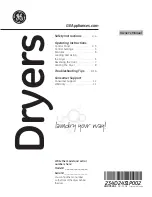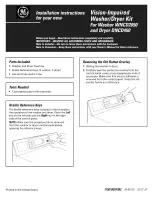
40
Many washing problems involve poor soil and stain removal, residues of lint and scum, and fabric damage. For
satisfactory washing results, follow these instructions.
Use ONLY powdered or liquid HE (High Effificiency) detergents. Do NOT use flakes scraped from a soap
cake or bar, flakes, soap ribbons (available in some markets,) detergent tablets, plastic pouches, magic
laundry balls, or anything other than powdered or liquid HE detergent products. Do not use soap of any kind.
Do not use other types of detergent or soap products, such as hand soap, dishwashng liquid, or any others.
4-4. TROUBLESHOOTING BY COMMON WASHING PROBLEMS
WASHING PROBLEM
Problems
Poor soil
removal
Blue Stains
Black or gray
marks on
clothes
Yellow or
brown rust
stains
Lint
Residue or
Detergent
Holes, tears,
or snags
Possible Causes
·
Insufficient detergent
·
Wash water temperature too low
·
Incorrect wash cycle
·
Laundry missorted
·
Stains not properly pretreated
·
Undiluted fabric softener
dispensed directly onto fabric
·
A buildup caused by the interaction
of fabric softener and detergent
can flake off and mark clothes
·
Not enough detergent
·
Iron or manganese in water
supply, water pipes, or water
heater
·
Incorrect sorting
·
Tissues left in pocket
·
Overloading the washer
·
Overloading the washer
·
Undissolved detergent
·
Excessive detergent
·
Incorrect use of chlorine bleach.
·
Unfastened zippers, hooks,
buckles
·
Ribs, tears and broken threads
·
Overloading the washer
·
Degradation of fabric
Solutions and Preventive Measures
·
Use correct amount of detergent for load size, amount of soil and
water hardness.
·
Use WARM or HOT water for normal soil. Different water
temperature may be required according to soil type.
(refer to page 10)
·
Reduce load size.
·
Wash with heavy or soak & heavy wash cycle for heavy soiled
laundry.
·
Separate heavily soiled items from lightly soiled ones.
·
Pretreat stain and heavy soil according to directions shown on
page 15.
·
Pretreat the stain with detergent or a stain removal agent.
·
Do not overfill fabric softener dispenser and do not pour liquid fabric
softener directly onto fabric.
See page 13 for more instructions.
·
Keep the recommendations against scum (waxy buildup).
·
Use correct amount of detergent for load size, soil level,
and water hardness.
·
To restore discolored load of whites, use rust remover safe for
fabric.
·
Install nonprecipitating water softener or an iron filter in your
water supply system for an ongoing problem.
·
Before washing, run water for a few minutes to clear lines.
·
Wash lint-producing items, like flannel sheets, towels, and the like
separately from dark fabrics and fabrics that tend to collect lint.
Remove all items, including tissues and papers, from the pockets of
items to be washed. See page 9 for sorting information.
·
Do not overload the washer.
·
Do not overload the washer.
·
Some detergents need to be pre-dissolved, check the
detergent instructions. Try pre-dissolving the detergent.
·
Increase water temperature using HOT water safe for fabric.
·
Use proper amount of detergent.
·
Never pour chlorine bleach directly on fabric.
See page 11 for adding liquid bleach.
·
Fasten zippers, hooks, and buckles.
·
Remove objects in pockets. See page 9 for caring before loading.
·
Do not overload the washer.
Summary of Contents for TS1800DPS
Page 2: ......
Page 17: ...16 3 3 FUNCTION OF EACH BUTTON 1 For Pump Model WFS1939EKD TS1804DPH ...
Page 18: ...17 ...
Page 19: ...18 2 For Non Pump Model WT SD153HVG WT SD173HVG ...
Page 20: ...19 ...
Page 21: ...20 3 4 WASHING PROGRAMS ...
Page 22: ...21 ...
Page 23: ...22 ...
Page 24: ...23 ...
Page 25: ...24 3 5 Other Functions ...
Page 26: ...25 ...
Page 27: ...26 ...
Page 28: ...27 ...
Page 29: ...28 ...
Page 30: ...29 ...
Page 31: ...30 ...
Page 32: ...31 ...
Page 54: ...53 5 EXPLODED VIEW TOP COVER ASSEMBLY CABINET ASSEMBLY TUB ASSEMBLY ...
















































